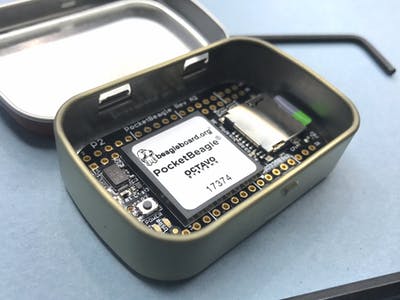Categories: Intermediate
When you get your PocketBeagle, you might overlook the getting-started instructions printed on the card insert, since they’re placed behind where the board sits. It’s pretty straightforward, but a little extra information is useful. Here’s a complete guide for setting it up; I’m using Mac OS X, and the instructions in the box work with Linux, Windows, or Mac computers.
First, as the packaging says, download the latest image file from
bbb.io/latest
I used a free Mac app, The Unarchiver, to decompress the .xz file into an .img – however, this step may not be necessary, as we’ll see in a minute. The image file itself is 3.57 GB, seven times bigger than the compressed XZ.
I used the free
Etcher
software, by
Resin.io
, to burn the image onto a blank 32GB SD card. It took maybe 10 minutes to burn and validate the image. Etcher looked like it was willing to take the XZ file as well, but I chose the already-decompressed .img in case it saved some time. I had to input my password to start the process.
When Etcher was done, it notified me of the success. Also, OS X threw an error about the card being unreadable. You should probably hit "Eject" here. I hit "ignore", instead, then got paranoid and used Disk Utility to eject the SD card before removing it from the computer.
The microSD card gives a satisfying click when it’s pushed in!
If you’ve done this right, when you insert the card and plug the board into your computer’s USB port, the whole row of four little blue lights will turn on and then start flashing. (I did this wrong first, a few times, and only the blue power LED turned on.)
Now, when you plug the board itself into your computer, it should show up as a drive:
Go ahead and open
START.HTM
to see what your board can do!
Options for interaction
Check out your PocketBeagle’s 101 page (192.168.6.2). You’ll be redirected to
http://192.168.6.2/bone101/Support/bone101/
which includes quick intros to BoneScript, Node-RED, the Cloud9 Javascript IDE, and more.
Next steps
There’s some great information available here:
https://github.com/beagleboard/pocketbeagle/wiki/FAQ
Here’s some great info about the onboard LEDs.
Note that the PocketBeagle does
not
include WiFi or Bluetooth; however, it’s possible to add those capabilities. You can use Node-Red, a visual programming environment, to program online interactions; just go to
http://beaglebone.local:1880/
in your browser.


Comments are not currently available for this post.